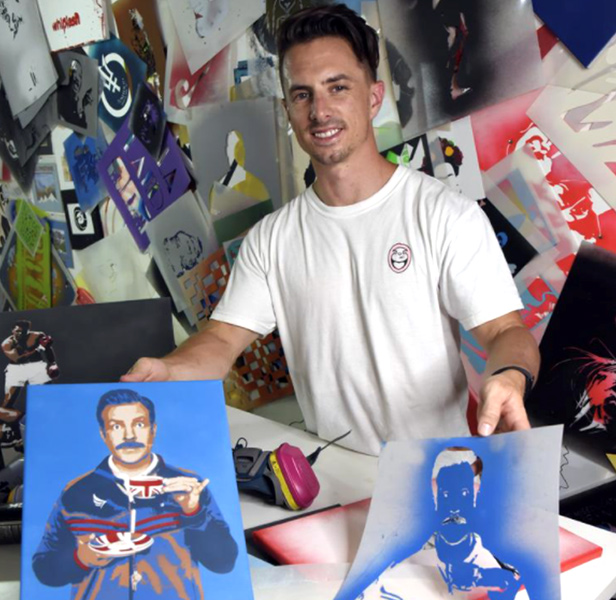Strategy November 12, 2021
Stencil Stop Traces a Path Toward Success
Custom stencils allow businesses to add a DIY sensibility to their logos.
Six years ago, Clemson University alumni Colin Mitchell and his roommate discovered they couldn’t buy a stencil of the school’s logo. So, they decided to create their own, and in the process, Mitchell ended up building a thriving business.

Colin Mitchell is the founder and CEO of Stencil Stop.
Mitchell used his background in design to create his first stencil, cutting out a couple of rough paw print designs from cardboard. He then set up a website to sell the stencils he’d created. The night the site went live, without any advertising, someone found it and bought one of the stencils. From that point on, Mitchell realized he had a business worth exploring.
As a packaging designer working for Pratt Industries, OtterBox and International Paper after graduating from Clemson, Mitchell had quickly discovered he wasn’t suited to the nine-to-five life. So, he quit his full-time job to go all in on Stencil Stop. Since its inception in 2015, the company has increased its revenue by about 340%, and Mitchell, as CEO, is constantly exploring ways to improve the business model.

Stencil Stop’s logo
Stencil Stop quickly moved beyond the Clemson paw print, creating custom stencils for artists and crafters, but also as promotional products for a variety of brands.
“Typically, people aren’t using our stencils to create art, but to promote their business, company or event in an interesting and unique way,” Mitchell says.
For example, the company worked with Adobe to create stencils of common symbols used by coders, so programmers can use the stencils to more easily sketch out the visual flow of an app they’re coding. The stencils were handed out during an event held by Adobe. Stencil Stop also worked with the NFL to create stencils for Super Bowl LIII in 2018. The stencils were used to paint fans’ faces in the stadium before the big game. Other notable brands the company has worked with include Netflix, Nike, Spotify, Lululemon and Lyft.
The rise of DIY – particularly during the pandemic – has been a boon to Stencil Stop, which shares projects and tutorials on the company blog and across social media. The company’s YouTube channel includes everything from a 45-minute tutorial on designing layered stencils to a short-and-sweet video explaining how to quickly paint your house number on the curb.
“People aren’t just buying a stencil,” Mitchell explains. “They’re looking for the end result for a project, and we can provide them with the answers.”
Stencil Stop’s approach has been particularly successful on TikTok, where it has more than 292,000 followers, and on Instagram, with more than 72,000 followers. Aesthetic videos of the detailed, layered stencil artwork process of creating a celebrity portrait or sports team logos tend to gain the most attention. A TikTok video showing how to use stencils to create a portrait of singer The Weeknd had been viewed more than 150,000 times.
@stencilstop Big shout to @davidglinski for showing me how to make something like this. Learn from others n try new stuff. It’s fun. 👀 #stencilstop #theweeknd #fy #fyp #satisfying #foryou #diy
♬ Starboy - The Weeknd
As Stencil Stop continues to grow, the e-commerce retailer has been adding employees and more laser cutters, and has moved into a larger warehouse. Mitchell is also exploring ideas for how to expand its offerings – perhaps by selling art supplies in addition to stencils, so that consumers can get everything they need to complete a project on the Stencil Stop website.
